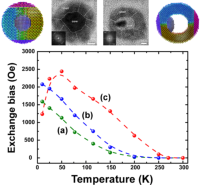




Projects-Highlights


Magnetic Nanostructure Characterization: Technology & Applications




Properties and features appearing on our magnetic structures of magnetic origin and affecting collective response.





MagnaCharta is settled in Balkan Center: KEDEK: Building A. Room: 0.3
++302310990576
magnacharta@physics.auth.gr






MagnaCharta, A.0.3, PO Box, Balkan Center-KEDEK, 57001, Thessaloniki-Greece
Properties

Morphology influence on nanoscale magnetism of Co nanoparticles
Co-based
nanostructures
ranging
from
core/shell
to
hollow
nanoparticles
were
prepared
by
varying
the
reaction
time
and
the
chemical
environment.
Both
structural
characterization
and
kinetic
model
simulation
illustrate
that
the
diffusivities
of
cobalt
and
oxygen
determine
the
growth
ratio
and
the
final
morphology
of
the
nanoparticles.
Exchange
coupling
between
Co
and
Co-oxide
in
core/shell
nanoparticles
induced
a
shift
of
field-cooled
hysteresis
loops
that
is
proportional
to
the
shellhickness,
as
verified
by
numerical studies.
Our Work
1.
Magnetism
and
anisotropy
in
core-shell
nanoparticles»,
O.
Crisan
et
al.,
J.
Opt.
&
Adv.
Mater.
5,
959
(2003).
DOI
2.
Structure
effects
on
the
magnetism
of
AgCo
nanoparticles,
O.
Crisan,
et
al.,
Acta
Materialia
54
5251–5260
(2006).
DOI
3.
Effect of air exposure on structural and magnetic features of FeCo nanoparticles», S. Mourdikoudis et al., Mod. Phys. Let. B 21 1161(2007).
DOI
4.
Field-assisted
organization,
substrate
effects
and
magnetic
behavior
of
Ag
30
Co
70
core-shell
nanoparticles»,
A.D.
Crisan
et
al.,Solid
State
Sciences
12 1907-1911 (2010)
.
DOI
5.
Morphology
influence
on
nanoscale
magnetism
of
Co
nanoparticles:
Experimental
and
theoretical
aspects
of
exchange
bias,
K.
Simeonidis
et
al.,
Phys. Rev. B 84 , 144430 (2011).
DOI
Composition and structural ordering effects on the magnetism of Pt-based magnetic nanoparticles
Spherical
(4
nm)
FePt
nanoparticles
were
synthesized
by
the
simultaneous
decomposition
of
Fe(CO)
5
and
the
polyol
reduction
of
Pt(acac)
2
.
The
final
Fe-to-Pt
composition
was
tuned
between
15-55
at.%
by
varying
the
ingredient
precursor
ratios.
Structural
ordering
is
promoted
in
all
cases,
though
samples
approximating
equiatomic
Fe/Pt
ratios
eventually
transform
to
fct-FePt
phase
while
the
FePt
3
-phase
is
favored
for
the
Pt-
richer
samples.
Consequently,
the
magnetic
features
of
the
annealed
nanoparticles
may
be
categorized;
the
hard
magnetic
FePt
region
dominating
for
Fe
content
between
40-55
at.%
and
the
soft
magnetic
FePt
3
region
dominating
in
the
region
20-30
at.%
while
Fe
content
less
than
20
at.%
results
in
Pt-richer
phases
with
diminishing ferromagnetic behavior.
Our Work
1. Tailoring the morphology of Co
x
Pt
1-x
magnetic nanostructures, S. Mourdikoudis et al. J. Magn. Magn. Mater. 321, 3120-3125 (2009).
DOI
2.
The
effect
of
composition
and
structural
ordering
on
the
magnetism
of
FePt
nanoparticles,
O.
Kalogirou
et
al.,
J.
Nanosci.
Nanotechn.
10
pp.
6017-
6023 (2010).
DOI
3.
Size-induced
effects
in
wet-chemically
synthesized
CoPt
3
nanoparticles,
S.
Mourdikoudis
et
al.,
J.
Nanosci.
Nanotechn.
10
pp.
6087-6092
(2010).
DOI
Ni-based magnetic multilayers: Layer-resolved magnetic moments
The
magnetic
moments
in
Pt/Ni
multilayers
are
thoroughly
studied
by
combining
experimental
and
ab
initio
theoretical
techniques.
SQUID
magnetometry
probes
the
samples'
magnetizations.
X-ray
magnetic
circular
dichroism
separates
the
contribution
of
Ni
and
Pt
and
provides
a
layer-resolved
magnetic
moment
profile
for
the
whole
system.
The
results
are
compared
to
band-structure
calculations.
Induced
Pt
magnetic
moments
localized
mostly
at
the
interface
are
revealed.
No
magnetically
"dead"
Ni
layers
are
found.
The
magnetization
per
Ni
volume
is
slightly
enhanced
compared
to
bulk
NiPt alloys.
Our Work
1.
Magnetic
anisotropy
energy
and
the
anisotropy
of
the
orbital
moment
of
Ni
in
Ni/Pt
multilayers»,
F.
Wilhelm
et
al.,
Phys. Rev. B61, 8647 (2000).
DOI
2. Layer-resolved magnetic moments in Ni/Pt multilayers, F. Wilhelm et al., Phys. Rev. Let. 85, 413 (2000).
DOI
3. X-ray magnetic circular dichroic magnetometry on Ni/Pt multilayers, P. Poulopoulos et al., F. Wilhelm et al., J. Appl. Phys. 89, 3874 (2001).
DOI
4.
Systematics
of
the
induced
magnetic
moments
in
5d
layers
and
the
violation
of
the
third
Hund’s
rule,
F.
Wilhelm
et
al.,
Phys.
Rev.
Let.
87,
207202
(2001).
DOI
5. Temperature-dependent magnetizations and anisotropies in Pd-Ni multilayers, E. Th. Papaioannou et al., Phys. Stat. Sol. (a) 189, 717 (2002).
DOI
6. Interface magnetism in 3d/5d multilayers probed by x-ray magnetic circular dichroism», F. Wilhelm et aL, Phys.Stat.Sol. (a) 196, 33 (2003).
DOI
7. Ni/Pt multilayers: growth and magneto-optics, E. Th. Papaioannou et al., Phys. stat. sol. (c) 1, No. 12, 3324–3327 (2004).
DOI
8,
Element-specific
hysteresis
loops
and
the
anisotropy
of
the
orbital
moment
of
Pt
in
Ni/Pt
multilayers»,
P.
Poulopoulos
et
a.,
J.
Magn.
Magn.
Mater.
272-276, 317 (2004).
DOI


















